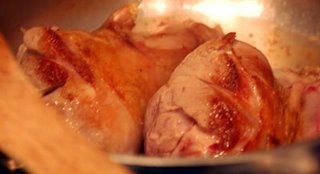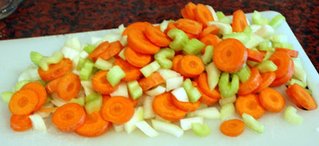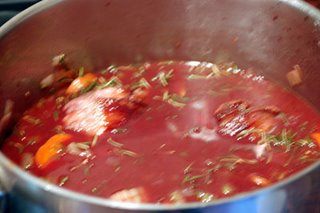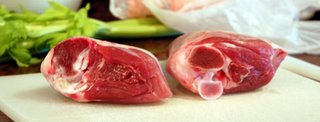There is a Daube cook off going on over at eGullet so I've joined in by both posting this recipe in Recipe Gullet & on the cooking/ daube cookoff thread with pictures. For this blog I've expanded a bit as well as putting the pictures in.
This is a recipe for braised Lamb Shanks. According to everything I've read it really is a daube by definition. No matter, I don't want to get into the semantics. The basic technique is applied to many peasant dishes whether they be lamb, beef, pork or, more luxuriously, veal. The meat is cooked slowly in wine or wine & water or wine & stock. Beef, especially the tough cuts used for these peasant recipies, is frequently marinated in wine & herbs prior to cooking.
I'm also not going to get into what kind of pot to cook it in or whether oven or stovetop is better. As you will see I've just used a deep pot for this version. One of the secrets whichever vessel is used is to make sure that you don't lose liquid by evaporation during the slow cooking process. Thus, covering the pot/ crock/ casserole is essential. Lose as little liquid as possible until the final reduction.
Suffice it to say that if the dish is slowly & carefully cooked with love & respect it is going to be delicious. The rest is nuance. Don't try to hurry or get fancy with this dish. Simple peasant cooking; take your time & you can't go wrong.
Here goes:
| 2 | Lamb Shanks | |
| 2—3 | yellow onions | |
| 3—4 | carrots | |
| 2—3 | stalk of celery | |
| 5—8 | cloves of garlic | |
| Lots of fresh rosemary | ||
| Lots of fresh thyme. | ||
| A few bay leaves | ||
| Hearty red wine | ||
| Good lamb stock | ||
| Salt & pepper. | ||
1) Put a small amount of fat into your pot. (duck is best, but others will do. Although you want high heat for the browning be careful not to burn the fat.) Heat this up & then put the shanks in and brown turning frequently; moderate the heat to prevent burning.
2) Meanwhile be chopping up the Onion, carrot, celery mixture. (How finely you chop depends upon how you plan to finish the dish. More on this later, but the rough chop I've illustrated is for a "stew like" finished product. A much finer chop is used where the mirapoix (onion, carrot, celery mix) is to be strained or run through a food mill for a more classic finish.
3) Peel & roughly chop the garlic. Remember that the garlic will mellow with the long cooking so don't be shy.
4) When the shanks are nicely browned remove them from the pot & set aside. Put the vegetable mixture along with the garlic & bay leaves into the pot, turn down the heat to low, cover the pot & sweat the mixture for at least 20 minutes.(just enough heat to cause the veggies to cook. When the onions are translucent & the carrots soft you're there. DO NOT LET THE VEGGIES BROWN!) 
5) Rub your rosemany & thyme as you strip the leaves from the stalks.
6) Put the lamb shanks back into the pot with the sweated veggies. Add the herbs. Add the wine & stock to just cover. (I like to use about 50% wine, 50% stock but try your own ratio. By hearty red wine I mean something like a Cahors in France or a Zifandel in the states. Cabernet works well. Nothing light.) Give everything a light seasoning.
7) Bring to the boil then back down to a simmer. Cover & simmer slowly for at least 3 hours. Check & stir occasionally. (This is where you can decide whether to cook in the oven or on the stovetop. If you have a stovetop burner you trust to keep a low simmer that's good. If not, you may be better off in the oven. It really depends upon your equipment & if the vessel you're using lends itself better to oven or stovetop.)
8) At the end of this first cooking take the shanks out & put them in the fridge separately from the vegetables & sauce.
9) Next day bring everything back up to room temperature having skimmed off any fat from the sauce. (there normaly won't be much if any if you are using lamb, beef will normally produce more fat. I'm not as concerned by fat as many so I'm not that meticulous about skimming. Let your own preference be your guide.)
Now its decision time. How to finish the dish as there are lots of variations.
A) My favorite 'classic' version. For this one I would have chopped the veggies much more finely. I would now add some crushed juniper berries (8-10 or so. I love juniper with either lamb or beef. Make sure the berries are well crushed to get their flovor.) and about 3 oz of tomato puree. Everything back into the pot for at least 2 hours covered. Adjust seasonings. Shanks out. Veggies & stock through a strainer or food mill then back into the pot for a final reduction. You shouldn't need to reduce very much. Add some dabs of butter just before serving to give a nice finish. Serve over potatoes, rice or other root vegetables.
B) An Italian, "osso bucco" slant. As in A, but no juniper. ( or, don't be shy & add the juniper anyway. It will further enrich the flavor.) Add oregano leaves & fennel seeds, the tomato puree & plus a can of italian plum tomatoes, drained. Cook as before except stir more often to crush the plum tomatoes. Serve over pasta, polenta or rice.
C) The 'stew' version. This is the one I've shown with roughly chopped veggies. I now, for the second cooking, add green lentils (about 4 oz per person) or white beans which have been soaked & pre-cooked. Everything together & cook for closer to 3 hours than 2. You can add turnips cut to eating sized chunks or a few parsnips for the last hour of cooking. Serve as is with crusty bread for sopping up the gravy.
There are about as many variations upon this basic recipe as there are cooks.
The important things are the slow cooking which for beef should be even slower than I've shown for lamb and the mirapoix to underpin the flavors.
Please try it. I'd love to hear of your results & your variations.


No comments:
Post a Comment